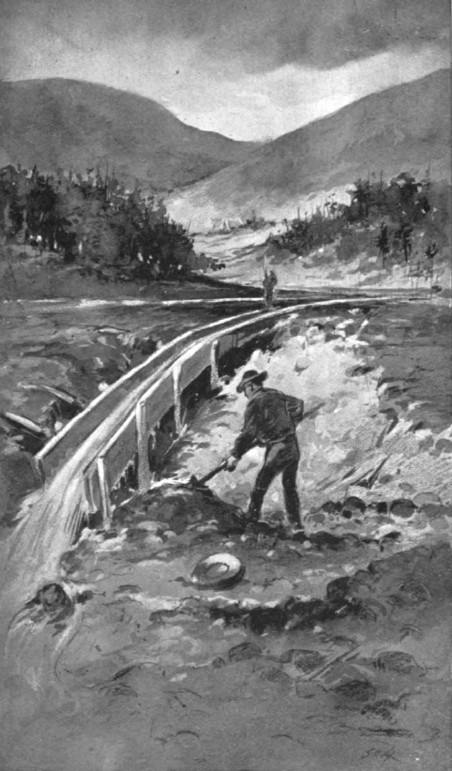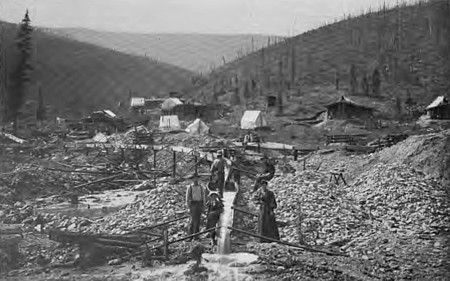The board-sluice is a long wooden trough, through which a constant stream of water runs, and into which the auriferous dirt is thrown. The water carries away the clay, sand, gravel and stones, and leaves the gold in the bottom of the sluice where it is caught by its gravity and by quicksilver. The board sluice is the great washing machine, and the most important instrument used for placer mining during the California gold rush. It washes nearly all the dirt and catches nearly all the placer gold of the country. It is said to have been invented here, although it had previously been used elsewhere; it has been more extensively employed in California than in any other country, and it can be used here to more advantage than elsewhere. The sluice is not less than fifty feet long, nor less than a foot wide, made of boards. The width is usually sixteen or eighteen inches ; and never exceeds five feet. The length is ordinarily several hundred and sometimes several thousand feet. It is made in sections or " boxes " twelve or fourteen feet long. .The boards are an inch and a half thick, and are sawn for that special purpose, the bottom boards being four inches wider at one end than the other. The narrow end of one box therefore fits in the wide end of another, and in that way the sluice is put together, a long succession of boxes, the lower end of each resting in the upper end of another, and not fastened together otherwise- These boxes stand upon trestles, with a descent varying from eight to eighteen inches in twelve feet.
It is therefore an easy matter to put up or take down a sluice after the boxes are made, and it is not uncommon for the miners to haul their boxes from one claim to another. The descent of a sluice is usually the same throughout its length, and is called its "grade." If there be a fall of eight inches in twelve feet, the sluice has an "eight-inch grade," and if the fall be twice as great, it is a "sixteen-inch grade." The grade depends upon the character of the pay-dirt, the length of the sluice, and its position. The steeper the descent, the more rapidly the dirt is dissolved, but the greater the danger also that the fine particles of gold will be carried away by the water. The tougher the dirt, that is, the greater its resistance to the dissolving power of the water, the steeper, other things being equal, should be the sluice. A slow current does not dissolve tough clay, and that is the greater part of the pay-dirt, so rapidly as a swift one. The shorter the sluice, all other things being equal, the smaller the grade should be. There is more danger that the fine particles of gold will be lost by a short sluice than by a longer one, and to diminish this danger, the rapidity of the current must be reduced by a small grade. The greater the amount of dirt to be washed, other things being equal, the steeper should be the grade; for a swift current will wash more dirt than a slow one. In many claims the pay-dirt is full of large stones and boulders,, weighing from one hundred to five hundred pounds each, all of which must be carried away through the sluice. Some are sent down whole, and others are broken into pieces with sledge hammers before they are thrown into the box. These require a swift current and a large body of water. The larger the supply of water, the steeper the sluice is made, other things being equal. Of course economy and convenience of working require that the sluice should be near the level of the ground, and as that may be steep or level below the claim, the grade of the sluice must to some extent conform to it.
There are thus a multitude of points to be taken into consideration in fixing the grade of a sluice; but a fall of less than eight or more than twenty inches, in a box of twelve feet, would be considered as unsuitable for the board-sluice. Sometimes the upper part of the sluice is made steeper so as to dissolve the dirt, and the lower part has a small grade to catch the gold. The clayey matter of ordinary pay-dirt is fully dissolved in a sluice two hundred feet long with a low grade, so the use of the boxes beyond that length is merely to catch the gold. There are claims however in which the clay is so extremely tough that it will roll in large balls more than a quarter of a mile through a steep sluice with a large head of water, and come out at the lower end scarcely diminished in size. The gold is caught in the sluice-boxes by false bottoms of various kinds. It would not do to leave the smooth boards, for the water would sweep all the gold away, and the boards themselves would soon be worn through. The most common false bottom is the longitudinal riffle-bar, which is from two to four inches thick, from three to seven inches wide, and six feet long. Two sets of these riffle-bars go into each sluice box, the box being twice as long as the bar. A set of riffle-bars is as many as fill one half of a box. They are wedged in, from an inch to two inches apart ; the wedging being used, because the bars can more readily be fastened in their places, and more easily taken up, than if nails were used. Before the work of sluicing commences, all the boxes are fitted with riffle-bars, and the bottom of the sluice is therefore full of holes from one to two inches wide, from three to seven inches deep, and six feet long. These are the places in which the gold, quicksilver, and amalgam are caught. Quicksilver is used now in nearly all the sluices, and is the more necessary the smaller the particles of gold. The large pieces of the metal would all be caught by their specific gravity without the aid of amalgamation.
The sluice boxes having been made, and set up with the proper grade, the water is turned in. The boxes are made of the rough boards as they come from the saw, and the joints are not waterproof, but the leaks are soon stopped by the swelling of the wood, or by the dirt. The stream of water in the sluice is at least two inches deep over the bottom. The height of the sides of the boxes is from eight inches to two feet. The sluice usually runs through the claim, and the auriferous dirt is thrown in with shovels, of which from four to twenty are constantly at work. A man will throw in from two to five cubic yards of dirt in one day. The water rushing- over, the dirt as it lies in the box, rapidly dissolves the clay and loam, and then sweeps the sand, gravel and stones down. The first dirt in the box goes to fill the spaces between the riffle-bars. After the sluicing has been in progress a couple of hours, some quicksilver is put in at the head of the sluice, and it gradually finds its way downward, most of it stopping, however, near where it is put in.
Sluices have their maximum discharge when set straight. Increased grade may be given below any unavoidable curves with advantage, and the outer side of the sluice must always be raised. Steps or "drops" in the sluices help in the recovery of the gold. In general, a grade of 6 to 8 inches along a 12-foot box is found best; this is equal to a 4.5 per cent grade. Exceptional instances are on record, however, where grades ran from 1 per cent to 8 per cent. In a 4 to 7 per cent grade the water in the sluice should be 10 inches deep at least. 'The longer the better," is the old time sluice-builder's motto. The best "riffles" are made of blocks of pine 8 to 13 inches deep, wedged across the bottom of the sluices. They are laid in rows separated by a space of a few inches. Riffle strips keep them in position, these latter being laid crosswise on the bottom. When worn down to five inches, the blocks should be replaced. This amount of wear will probably require six months. Stone and longitudinal riffles running lengthwise of the box are often preferred. An undercurrent is a broad sluice set at a heavy grade below the level of the main sluice. The fine stuff drops through a grating, while the coarse gravel continues on down the sluice. Refuse material from quartz, hydraulic or other mines is known as tailings. Tailings are deposited on a dump, which in the case of a hydraulic claim must be sufficiently spacious to receive the thousands of yards of debris deposited on it each day. When available a narrow, deep canyon, or a tunnel, may take the places of dumps. Quicksilver is used in the sluices, 14 to 18 flasks being used every fortnight in a long sluice. It is not placed in the last 300 or 400 feet.
Continue on to:
Using a Sluice Box, Part II - Historic placer Mining
Return To:
Historic Placer Mining Technologies


